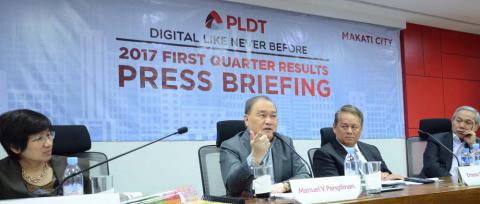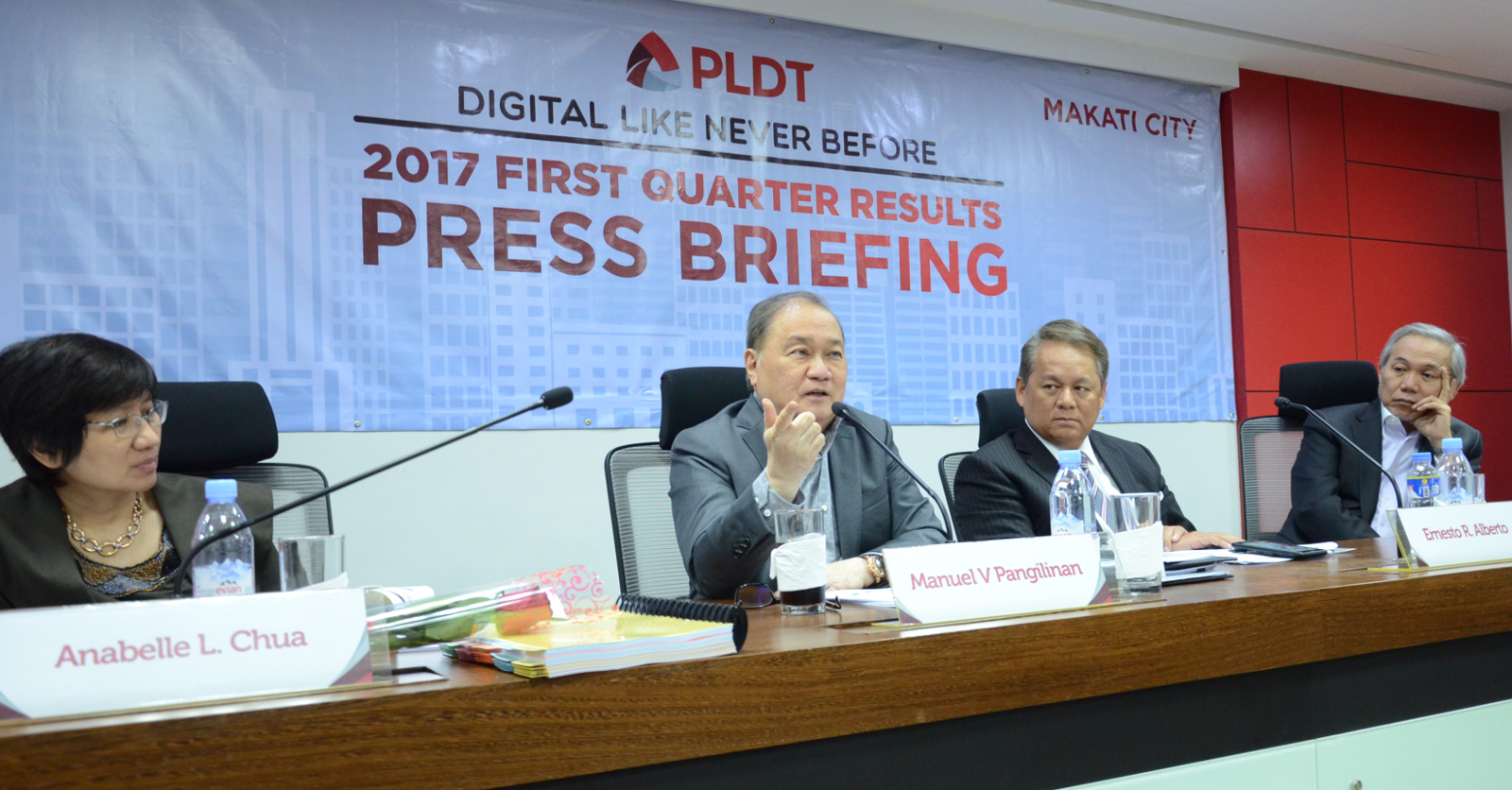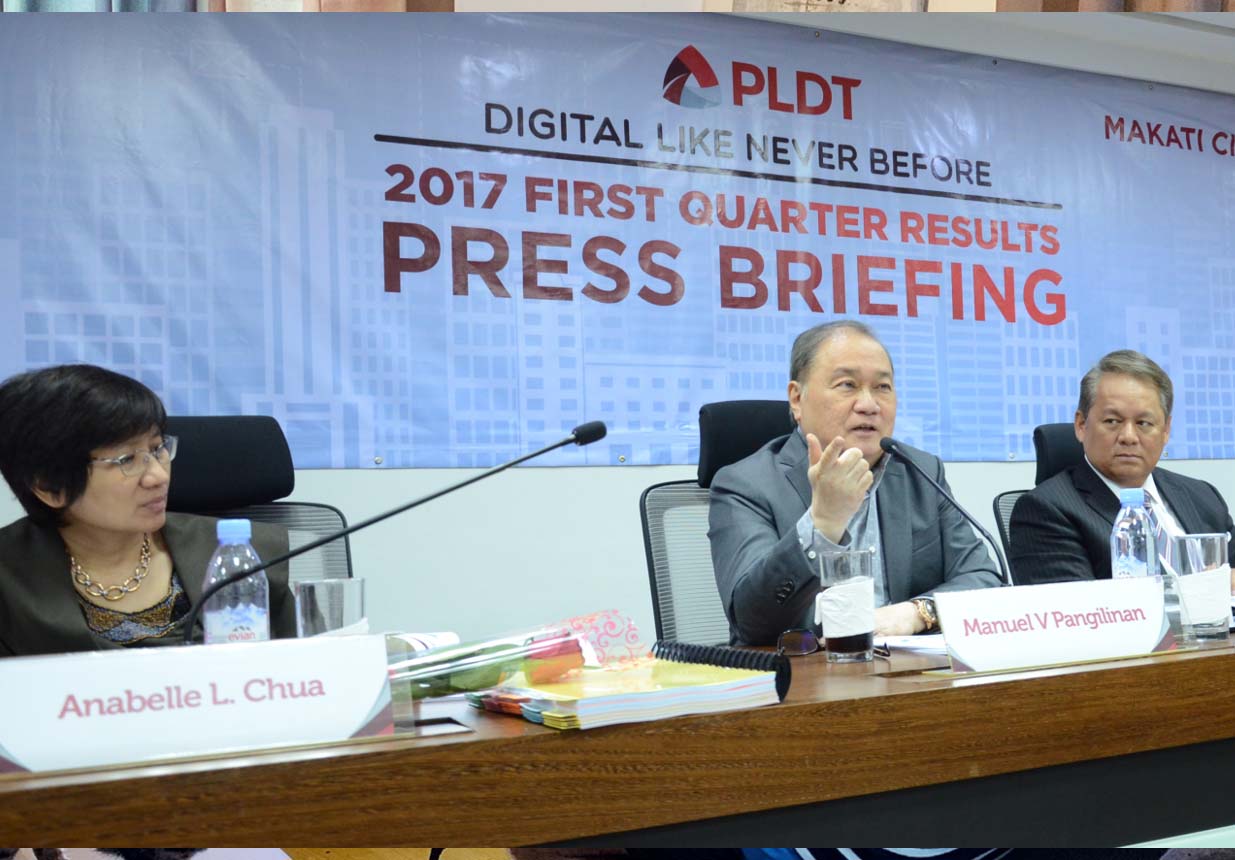
PLDT Inc. today announced its unaudited financial and operating results for the first quarter of 2017 with consolidated service revenues (net of interconnection costs) at P35.6 billion.

This is 7% less than the services revenues year on year but only 1% lower than service revenues in the fourth quarter of 2016, in line with the objective to arrest the negative momentum of the topline.
Fixed service revenues (net of interconnection costs) amounted to Php16.9 billion, up 10% year on year, while Wireless service revenues (net of interconnection costs) reached Php20.8 billion, 16% lower than the previous year. Quarter on quarter, fixed service revenues increased by 4% while wireless revenues declined 4%.
Consolidated Core Income, excluding the gain from asset sales and EBITDA adjustments in the Q1 2016 (subsidies and provisions), reached Php5.3 billion, 26% less than a year ago. However, compared to the previous quarter, Recurring Core Income in Q1 2017 rose by Php1.7 billion, or 46%, because of higher EBITDA.
Consolidated EBITDA amounted to Php16.5 billion, 1% less than Q1 2016, but 7% higher than Q4 2016, marking three consecutive quarters of improvement in EBITDA. This was due primarily to lower provisions and lower subsidies that compensated for lower revenues.
EBITDA margin was 44%, an improvement from 41% a year ago and 40% in the previous quarter.
As of end-March 2017, Consolidated Net Debt stood at US$2.7 billion while Net Debt to EBITDA was 2.2x. Gross Debt reached US$3.5 billion, only 25% of which are denominated in US$ compared to 32% as of end-2016 following the refinancing in pesos of the 8.35% US$ bond which matured in March 2017. Taking into account available US$ cash and hedges, only 9% of total debt is unhedged, while 91% of our debt are fixed-rate loans, post-interest rate swaps.
“As we indicated earlier, our focus since the latter part of 2016 has been to stabilize the overall business, which involves stemming the decline of revenues and profitability in the wireless consumer segment, sustaining the upward momentum in the Home and Enterprise businesses and laying the ground for recovery through the digital transformation of our businesses. We’ve produced encouraging results in the first quarter this year, thanks to the continued strong growth posted by our Home and Enterprise businesses, whilst our Wireless Consumer Group re-doubled efforts to break the negative momentum and hold the line,” said Manuel V. Pangilinan, Chairman and CEO of PLDT and Smart Communications.
Home and Enterprise take the lead
PLDT’s Home and Enterprise Business units led the way in the first quarter of 2017, posting double-digit revenue increases year-on-year. Home service revenues (net of interconnection costs) reached Php7.8 billion, up 12%, while Enterprise service revenues (net of interconnection costs) rose to Php8.5 billion, climbing 13% versus Q1 2016.
The combined revenues of Home and Enterprise Groups, now make up 46% of consolidated service revenues, higher than the 41% contribution of the Wireless Consumer business of Smart, TNT and Sun.
The Wireless Consumer Group posted service revenues of Php14.7 billion, 18% lower than the same period last year largely due to declines in SMS and voice revenues. On a quarter on quarter basis, however, the rate of decline of Wireless Consumer revenues slowed down to 2%, the difference between the two quarters stemming from the first quarter having two days less than the fourth.
Moreover, the combined subscriber base of Smart, TNT and Sun rose by about 400,000 in the first quarter of 2017 from end-2016.
Data powers growth
Data has powered revenue growth across all the major business units, with Enterprise and Home providing the fulcrum for PLDT’s digital pivot.
In the first quarter of 2017, data and broadband revenues grew 10% year on year to Php15.9 billion and comprised 44% of consolidated revenues. On segment basis, data and broadband accounted for 62% and 33% of fixed and wireless service revenues, respectively. Mobile internet revenues grew 20% year on year to Php4.6 billion. Corporate data and data center revenues increased 17% to Php4.9 billion while Home broadband revenues rose 15% to Php4.7 billion.
In terms of their share of revenues per major business group, data and broadband accounted for 66%, 61% and 37% of the first quarter 2017 revenues of Enterprise, Home and Wireless Consumer Businesses, respectively.
“In pursuing digital transformation, we are building on our strengths as the country’s leading integrated communications and digital services group with the most extensive and resilient wired and wireless networks and digital infrastructure. Through those platforms, we are offering a growing range of services and solutions that go beyond access and meet the increasingly digital needs of our customers,” said Ernesto R. Alberto, PLDT Group Chief Revenue Officer.
“Our advantages in the fixed line business – particularly our brand strength and extensive network reach – is providing us a significant competitive edge since there is much more headroom for growth in fixed moving forward,” he added.
Wired and Wireless Network Roll-out
Underpinning its revenue growth is PLDT’s extensive roll out of both wired and wireless networks.
In the first quarter 2017, PLDT expanded the reach of its fiber optic network to cover over 3 million homes passed, up from 2.8 million homes at end-2016 and tracking well vis-à-vis the 4.4 million homes target by end-2017. This is supporting the more extensive delivery of fiber to the home (FTTH) services in key urban centers in various parts of the country.
In line with this, PLDT launched its fiber-powered PLDT SmartCity program (previously “Fibr City” program) first in Toledo City, Cebu in February, then in General Santos City
in April and then Naga City in May. Working with city governments of these key urban centers, PLDT is deploying high-speed world-class internet connectivity to more homes, providing a wide range of entertainment, home security and other digital services.
Complementing its stepped up FTTH roll-out, PLDT is also set to start deploying in the second quarter of this year hybrid fiber technologies like G.fast that can deliver fiber-like data speeds through the copper wires in homes and buildings under a three-year program.
Meanwhile, PLDT Enterprise has been expanding its digital infrastructure to serve the growing need of companies and government agencies for disaster recovery and cloud-based digital solutions.
In February this year, PLDT subsidiary ePLDT inaugurated its eighth and ninth Vitro Data Center in Davao City and Clark Freeport Zone, Pampanga, respectively. By year-end, the PLDT Group will have ten data centers with a total capacity of about 9,000 racks – more than three times the capacity of the next largest competitor.
Built to strict international standards, the Vitro Data Centers provide companies secure, disaster-resilient facilities to store their mission-critical data and to host the growing range of cloud solutions that businesses are tapping to improve efficiencies and better serve their customers.
Meantime, Smart has stepped up the expansion of the coverage and capacity of its LTE and 3G networks to better serve the rising demand for mobile data services. After completing its initial deployment in Metro Davao late last year, Smart brought its LTE and LTE-Advanced roll out to Metro Cebu and Metro Manila and surrounding provinces. Under its three-year plan submitted to the National Telecommunications Commission, Smart will provide LTE coverage to 95% of the country’s cities and municipalities by 2018 using low- and high-band radio frequencies, including those obtained through the acquisition of the telecoms businesses of San Miguel Corporation.
Already, Smart’s LTE service is posting average data speeds of around 18-20 Mbps as well as improved indoor data coverage in those areas, according to internal tests. Where LTE-Advanced cell sites are available, data speeds of 80-90 Mbps are being attained. As a result, third party crowd-sourced tests are bearing out that Smart is offering the fastest LTE service in the country.
Even as Smart builds its LTE network, it is already preparing for the next stage of development in mobile technologies. For this purpose, Smart struck an agreement in February 2017 with technology partner Huawei Technologies Philippines to jointly conduct research and development on 5G, or fifth-generation wireless broadband technology. In December 2016, Smart conducted 5G tests with technology partner Nokia, achieving speeds of up to 2.5 Gigabits per second (Gbps) using 100 MHz with latency of just 1 millisecond for the first time in the Philippines over a 'live' network.
Complementing its LTE and 3G roll-out, Smart is also deploying its WiFi service in key public spaces in various parts of the country. Carrier-grade Smart WiFi is now available at major airports such as those in Metro Manila, Metro Davao, Bacolod, Iloilo, Clark, Zamboanga, Dumaguete, Laoag, General Santos, Kalibo and Puerto Princesa. Smart Wifi has also been installed in the key sea ports such as in Batangas City, Calapan City of Mindoro, Puerto Princesa, Dumaguete and Dapitan. It is also now available in LRT 1 light rail transit system in Metro Manila.
In the first quarter of 2017, Smart WiFi has been launched in such tourist spots as the Gloria de Dapitan’s Fantasyland in Dapitan City and Aurora Park in Laoag City, and is set to be rolled out in the Manila Ocean Park and the Dahilayan Adventure Park in Manolo Fortich, Bukidnon, Mindanao in the coming weeks. “Smart Spots” are also being set up in popular entertainment and restaurant centers such as The Yard in Xavierville and Pasig; South StrEAT in Maginhawa St., Quezon City and at Cavite, along the Silang-Tagaytay Road and the Matina Town Square in Davao City.
“We are building for the future by further strengthening the combined reach and capabilities of our wired and wireless networks. And we are doing this in ways that are very mindful of impending advances in technologies such as 5G, so that our current network investments will deliver benefits not only today but also well into the future,” said Joachim Horn, PLDT Group Chief Information and Technology Adviser.
Going Beyond Access
Leveraging on its more powerful data networks, PLDT and Smart have introduced more digital services and solutions that go beyond access.
In March, PLDT, Smart and Cignal TV announced an exclusive partnership with Fox Networks Group Asia that enable subscribers to stream movies and TV programs from the 11,000 hours of video content of global entertainment leader Fox. This includes Hollywood blockbusters and hit TV series. Moreover, they can watch live sports events like NBA. All this content can viewed either at home via fixed broadband, or, on the move via mobile internet on smart phones.
In April, PLDT launched the next generation of its TVolution video streaming box in partnership with global streaming pioneer Roku, Inc. This enables Filipinos to be the first in Asia to view leading video content using the proven Roku streaming platform.
“Video is the main driver of data usage. As a result of our previous content agreements with industry leaders like iflix, Netflix and iWantTV, video consumption on Home Broadband has increased four times, year on year. Our new partnerships with Fox+ and Roku have further enriched our content portfolio and will help accelerate the growth of our data and digital business,” said Oscar Enrico Reyes Jr., PLDT FVP and Head of HOME Business
To meet the growing appetite of business and government for digital solutions, PLDT Enterprise introduced its Smart SOS Dispatch, a cloud-based emergency response solution that enables local governments, private companies and organizations to efficiently manage communications between their command center and first responders in the field during emergency situations.
PLDT also tied up with US-based global IT leader Cisco to introduce next-generation business solutions starting with enterprise-class WiFi connectivity for large and small companies. These solutions enable companies to manage more effectively and securely the WiFi connectivity they provide their customers and employees.
“Business and government agencies – large and small – are now more keenly interested in tapping digital and cloud solutions to boost their efficiency and effectiveness. By leveraging on our advantages such as our superior data center network, we are increasing our business with industries such as banking and finance, outsourcing, and SMEs at a pace faster than the growth rates of these industries,” said Juan Victor Hernandez, PLDT Senior Vice President and Head of PLDT and Smart Enterprise.
To make data services more accessible to its mobile phone subscribers, Smart and Sun have revamped their postpaid plans and prepaid packages with bigger data packages bundled with more flexible offers of voice calls, SMS and smart phones.
Smart’s new postpaid plans start at Plan 399 which comes with 3Gb of data all the way up to Plan 2999 with 36Gb of data. Each plan comes with built-in call minutes and SMS to all networks. Subscribers can further boost their basic postpaid plan by registering to Flexibundles which provide a variety of call, text and data offers that they can mix and match every month. Subscribers can also choose their preferred handset from among Smart’s portfolio of devices and amortize payments for it via their monthly bills.
Similarly, prepaid subscribers are benefitting from a greater range of choices. For example, TNT launched in April its TNT Choose Your Tropa Apps. For only Php20, the prepaid subscriber can choose 3 mobile apps to use for three days. Depending on his or her preference, the subscriber can opt to get apps for chatting, sharing social media updates, watching viral videos or playing mobile games.
Smart has also partnered with China-based developer Moonton to offer in-app perks and enhanced experiences for fans of the hit game Mobile Legends. Launched in 2016, Mobile Legends is a real-time online battle arena game that pits two teams of five players against each other in a race to attack and overcome their enemy’s towers and thrones.
“We are growing our wireless business by providing better, faster network services and offering customers a wider range of more flexible choices that more closely suit their preferences. We continue to build partnerships with leading providers of popular digital content and services that add color to digital lifestyles of our customers,” said Alberto.
Voyager Innovation and its subsidiaries and affiliates have introduced new financially inclusive services on the back of its digital financial services platforms.
Through its fintech arm FINTQnologies Inc. (FINTQ), it has just launched TxtMed, the country’s first medicine loan service. TxtMed allows government and private sector employees with LANDBANK payroll accounts to purchase Ritemed medicines through their mobile phones via an instant loan.
To provide financial access to more Filipinos, especially those in the rural areas and underserved sectors, FINTQ introduced the ASEAN region’s first mobile-based digital agricultural crop loan in collaboration with Producers Bank, via the digital lending platform, Lendr. Also via Lendr, the Camalig Bank, Inc., together with FINTQ, have started rolling out mobile-based salary loan applications in remote areas of the Bicol region for teachers and employees from the Department of Education and local government units.
On the consumer side, PayMaya e-wallet and mobile app continues to show strong adoption as the prepaid payment of choice for the country’s millennial generation. The brand launched in April its #NowNation: Beyond The Selfie campaign highlighting the power and social contribution of financially-savvy young Filipinos as change agents and value creators.
“Around 16 million Filipinos are now enjoying access to the digital life using Voyager's various platforms in the areas of access and customer engagement, digital commerce, fintech and payments. We will create more value by enabling both enterprises and consumers to participate in this growing digital community,” said Orlando B. Vea, President and CEO of Voyager Innovations.
Conclusion
“It is perhaps auspicious that the franchise of Smart Communications was renewed and extended for another 25 years by Congress, and then signed into law by President Rodrigo Duterte on April 21. We are grateful for this action by Congress, the Senate and the President. In a way, this marks a new beginning for Smart and indeed for PLDT as well. The next 25 years will be very different from the previous 25. The world today is turning deeply digital. And, as our results for the first quarter this year show, PLDT and Smart are moving with the times and making their digital pivot at an accelerating pace,” Pangilinan said.
“Led by our Home and Enterprise business units, we are at the cusp of crossing the 50% threshold in terms of the share of data and digital revenues out of total revenues. Also, as the quarter on quarter results in service revenues, EBITDA and core income suggest, we are levelling off from our descent path, and are at the threshold of returning to the growth track in the second half of the year. Going digital is the difficult but only viable path to growth. It is thus with watchful optimism that we are maintaining our guidance for Full Year Recurring Core Income (before exceptionals) at Php21.5 billion,” he added.


